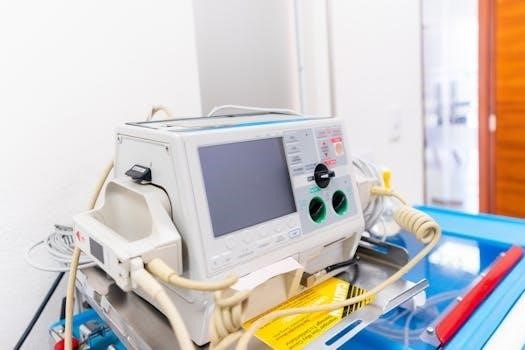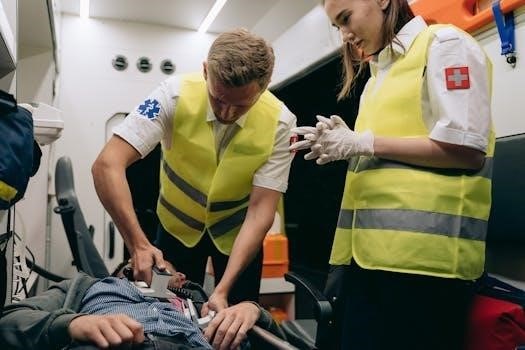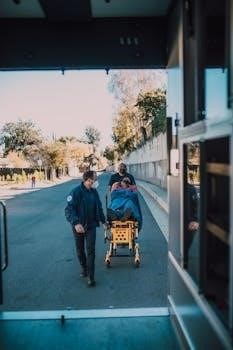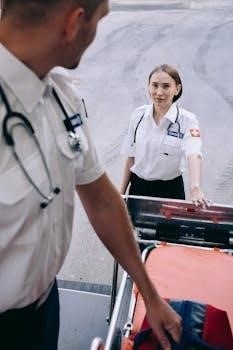American Red Cross First Aid/CPR/AED Participants Manual Overview
The American Red Cross First Aid/CPR/AED Participants Manual is essential for courses. It imparts vital knowledge and skills. Participants learn immediate care techniques for injured or ill individuals. The manual aids in determining the necessity of advanced medical intervention.
Purpose of the Manual
The primary purpose of the American Red Cross First Aid/CPR/AED Participants Manual is to equip individuals with the knowledge and skills necessary to provide immediate assistance to those experiencing medical emergencies. This comprehensive manual serves as a cornerstone for various American Red Cross courses, designed to empower participants to confidently respond to injuries and sudden illnesses.
Through clear instructions and illustrative examples, the manual guides readers through essential first aid techniques, CPR protocols, and the proper use of automated external defibrillators (AEDs). It emphasizes the importance of early intervention, enabling individuals to stabilize a situation until professional medical help arrives. Furthermore, the manual promotes informed decision-making, helping participants assess the severity of a situation and determine when advanced medical care is required. By fostering a culture of preparedness and empowering individuals to act decisively, the American Red Cross First Aid/CPR/AED Participants Manual plays a critical role in enhancing community safety and resilience.

Key Components of Adult CPR, AED, and Choking
Adult CPR involves chest compressions and breaths. AED usage includes pad placement and analysis. Addressing choking focuses on abdominal thrusts. These components help save lives during emergencies, and the manual will guide you through them.
Compressions and Breaths
In adult CPR, chest compressions are paramount. Place the heel of one hand in the center of the chest. Put the other hand on top, interlacing fingers. Deliver compressions that are at least 2 inches deep. Maintain a rate of 100-120 compressions per minute, allowing complete chest recoil between each.
After 30 compressions, give two rescue breaths. Ensure the airway is open using a head-tilt-chin-lift. Pinch the nose closed and create a tight seal over the mouth. Each breath should last about one second and make the chest rise visibly. Continue cycles of 30 compressions and two breaths until help arrives or an AED is ready for use. Proper technique is vital for effective CPR.
Mask use during breaths is recommended to prevent disease. If you do not have a mask, continue CPR. If you are not trained, focus on compressions alone.
AED Usage for Adults
When using an AED on an adult, prompt action is crucial. First, power on the AED and adhere to the voice prompts. Remove any clothing covering the chest to ensure proper pad placement. Attach one pad to the upper right side of the chest and the other to the lower left side, below the armpit.
Make sure that no one, including yourself, is touching the person during analysis or shock delivery. The AED will analyze the heart rhythm and advise whether a shock is needed. If a shock is advised, announce “clear” loudly to ensure everyone steps away. Press the shock button as directed.
After delivering the shock, immediately resume CPR, starting with chest compressions; Continue following the AED‘s prompts until emergency services arrive or the person shows signs of recovery. Early defibrillation significantly increases survival rates during cardiac arrest.
Addressing Choking in Adults
When an adult is choking, rapid intervention is crucial. First, ask “Are you choking?” If the person nods or cannot speak, they need help. Encourage them to cough forcefully. If coughing doesn’t dislodge the object, prepare to give abdominal thrusts (Heimlich maneuver). Stand behind the person and wrap your arms around their waist.
Make a fist with one hand and place the thumb side against the middle of their abdomen, just above the navel. Grasp your fist with your other hand and give quick, upward thrusts into the abdomen. Continue these thrusts until the object is dislodged or the person becomes unresponsive.
If the person becomes unresponsive, carefully lower them to the ground and begin CPR, starting with chest compressions. Each time you open the airway to give breaths, look for the object. If you see it, remove it. Continue CPR until emergency services arrive.

Key Components of Child CPR, AED, and Choking
Child CPR differs from adult CPR in several crucial aspects. Assessing responsiveness and activating the emergency response system remain paramount. However, compression depth and hand placement are modified. Use one or two hands for compressions, depending on the child’s size, compressing about two inches. Deliver 30 compressions followed by two breaths, similar to adult CPR if you’re alone.
When using an AED on a child, use appropriately sized pads if available. If not, adult pads can be used, ensuring they don’t touch each other on the child’s chest. For choking, if the child is conscious, deliver abdominal thrusts. If they become unconscious, begin CPR, checking for an object in the mouth before each breath.
Remember, early intervention is critical. Adapt your techniques based on the child’s size and age, always prioritizing effective compressions and ventilation.
Ready Reference (Pediatric) First Aid/CPR/AED
This section offers a concise guide for pediatric emergencies. It covers CPR steps, AED usage, and choking relief. Quick access to these guidelines enhances effective response. Prioritize safety and follow instructions carefully.
AED Pad Placement for Pediatric Use
Proper AED pad placement is crucial when administering aid to children. For infants and smaller children, standard adult pads are often too large and can potentially cause harm. In these situations, use pediatric pads if available. These pads are designed to deliver a lower dose of electricity, which is safer for a child’s smaller body.
If pediatric pads are unavailable, you can use adult pads. However, it is essential to ensure that the pads do not touch or overlap. A common technique is to place one pad on the center of the chest and the other on the back, between the shoulder blades. This anterior-posterior placement helps to avoid the risk of electrical arcing and ensures effective delivery of the electrical shock.
Always follow the AED‘s voice prompts and visual aids. The device will guide you through the steps and advise on pad placement based on the child’s size. Remember, speed and accuracy are vital in these situations. Regularly review and practice these techniques to be prepared for an emergency.
Program Design of the American Red Cross First Aid/CPR/AED Program
The American Red Cross First Aid/CPR/AED program is meticulously designed to equip participants with the knowledge and skills necessary to respond effectively to emergencies. The program offers a variety of courses and modules. These can be combined to meet the specific needs of different audiences. Courses range from basic first aid to comprehensive CPR and AED training.
The curriculum includes hands-on practice sessions. Participants learn how to assess an emergency situation, provide appropriate care, and activate emergency medical services. The program emphasizes the importance of early recognition of signs and symptoms. It also focuses on the correct application of first aid techniques.
The program incorporates the latest guidelines and best practices. It ensures that participants receive up-to-date and evidence-based training. The modular design allows for flexibility in delivery. Instructors can tailor the program to suit the specific needs of their students, ensuring optimal learning outcomes and preparedness.

Environmental Emergencies Covered in the Manual
The First Aid/CPR/AED Participants Manual comprehensively addresses various environmental emergencies. These emergencies can arise from interactions with the surrounding environment. The manual offers detailed guidance on recognizing, preventing, and managing these situations. It equips individuals with the skills to respond effectively when faced with such crises.
The manual covers topics like heat-related illnesses, including heatstroke and heat exhaustion. It explains the importance of hydration and recognizing early warning signs. Cold-related emergencies, such as hypothermia and frostbite, are also discussed in detail. The manual provides instructions on warming techniques and preventing further heat loss.
Furthermore, the manual addresses emergencies related to bites and stings from insects and animals. It outlines steps for managing allergic reactions and preventing infections. It also covers water-related emergencies, such as drowning and near-drowning incidents. The manual emphasizes the importance of water safety and rescue techniques.
Instructor Candidate Requirements
Becoming an American Red Cross First Aid/CPR/AED instructor involves meeting specific requirements to ensure quality training. Candidates must possess a current First Aid/CPR/AED certification, demonstrating proficiency in essential skills. They also need to be at least 16 years old, showing maturity and responsibility.
A strong aptitude for teaching and excellent communication skills are crucial. Candidates should demonstrate the ability to effectively convey information and engage participants. They must complete the American Red Cross Instructor Training Course, which covers instructional methods and course management.
Successful completion of the instructor course requires passing both written and practical exams. These assessments validate the candidate’s knowledge and skills in teaching First Aid/CPR/AED. Affiliation with an authorized American Red Cross Training Provider is necessary to conduct courses. Instructors must adhere to Red Cross policies and maintain current certifications.

Importance of CPR and First Aid Skills
CPR and first aid skills are invaluable for every individual, enabling effective responses in emergencies. These skills can significantly improve outcomes during critical situations, potentially saving lives. Knowing CPR allows one to maintain blood flow and oxygen supply to the brain and vital organs until professional medical help arrives.
First aid skills equip individuals to handle various injuries and illnesses, providing immediate care and comfort. From minor cuts to severe burns, first aid knowledge ensures appropriate initial treatment. Prompt and effective first aid can prevent conditions from worsening, reducing the risk of long-term complications.
Moreover, possessing these skills fosters confidence and preparedness in emergency scenarios. Trained individuals are more likely to act decisively and efficiently, reducing panic and improving overall response. CPR and first aid skills empower individuals to become vital links in the chain of survival, making communities safer and more resilient.
Availability of Manuals and Resources
The American Red Cross First Aid/CPR/AED Participants Manual, a vital resource for learning life-saving skills, is readily accessible through multiple channels. Individuals can purchase physical copies of the manual from the American Red Cross website or authorized training providers. Digital versions, including PDF formats, are often available for convenient access on electronic devices.
In addition to the primary manual, supplementary resources enhance the learning experience. These may include quick reference guides, posters illustrating key techniques, and online video tutorials. The American Red Cross Learning Center provides a comprehensive platform for accessing course materials and additional support.
Furthermore, various websites and libraries offer first aid and CPR information, though it is crucial to ensure these sources align with current guidelines. By making these manuals and resources widely available, the American Red Cross aims to empower more individuals with the knowledge and skills needed to respond effectively in emergencies.
